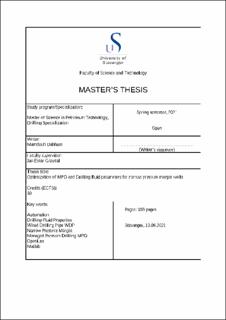| dc.description.abstract | The last ten years have witnessed a growing interest in the evolution of technology
and autonomous systems in drilling operations after the oil and gas companies realized that the next stage in the exploration and production of oil gas is to drill
more wells, often characterized by narrow pressure margins. The drilling challenges
in narrow margin pressure wells such as depleted reservoirs, deep water, extended-reach wells (ERD) and High-Pressure High Temperature (HPHT) wells require more
accuracy and high sensitivity in drilling operations. These wells are more susceptible
to drilling incidents such as formation influx, lost circulation, and pack-off, leading
to increased non-productive time (NPT) and increased costs.
The introduction of the automation process in drilling systems based on automated
tools during drilling operations such as wired drill pipe (WDP) and along-string measurements (ASM) was required to reduce the NPT, thus reducing the drilling costs
and keeping the humans away from the hazardous area. Additionally, an automated
the system is intended to optimize the drilling operations by monitoring, modelling and
controlling the acquisition data, which are real physical measurements transmitted
from the well downhole.
The Managed Pressure Drilling (MPD) methodology with different variants and
techniques is seen to be a promising solution during drilling operations in narrow
pressure margin wells compared to conventional drilling methods. By utilizing automated back-pressure control, together with a more accurate flow meter, such as the
Coriolis flowmeter, it is possible to react rapidly to any unindented influx and to
compensate for pressure variations during circulation and connection.
Drilling fluid properties and rheology play an essential role during drilling operations.
Choosing the proper mud density, viscosity, and rheology is a key to maintaining
equivalent circulating density (ECD) between formation pore pressure gradient and
fracture pressure gradient, thus avoid drilling problems such as formation influx,
lost circulation and stuck pipe.
In this thesis, the OpenLab drilling simulator provides synthetic measurements that
are used to create a workflow algorithm that selects the optimum set-points for
MPD back-pressure and drilling fluid properties. Optimization of the MPD method
and selecting proper drilling fluid properties during drilling help to maintain the
bottom-hole pressure (BHP) and prevent lost circulation, kick occurring and other
drilling incidents and thus maintain the wellbore in safe mode. | |
